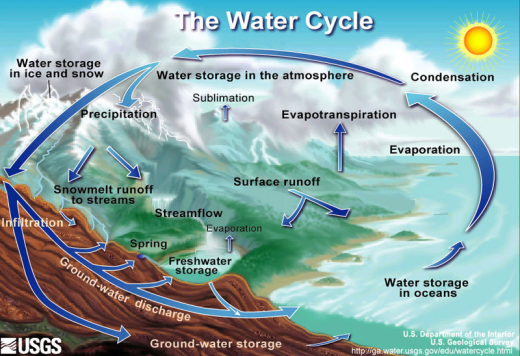Precipitation is any product of the condensation of atmospheric water vapor that is deposited on the Earth's surface. The main forms of
precipitation include rain, snow, ice pellets, and graupel. It occurs when the atmosphere, a large gaseous solution, becomes saturated
with water vapor and the water condenses, falling out of solution (i.e., precipitates). Two processes, possibly acting together, can lead
to air becoming saturated: cooling the air or adding water vapor to the air. Virga is precipitation that begins falling to the earth but
evaporates before reaching the surface; it is one of the ways air can become saturated. Precipitation forms via collision with other rain
drops or ice crystals within a cloud.
Moisture overriding associated with weather fronts is a major method of precipitation production. If enough moisture and upward motion is
present, precipitation falls from convective clouds such as cumulonimbus and can organize into narrow rain bands. Where relatively warm
water bodies are present, for example due to water evaporation from lakes, lake-effect snowfall becomes a concern downwind of the warm
lakes within the cold cyclonic flow around the backside of extratropical cyclones. Lake-effect snowfall can be locally heavy. Thundersnow
is possible within a cyclone's comma head and within lake effect precipitation bands. In mountainous areas, heavy precipitation is
possible where upslope flow is maximized within windward sides of the terrain at elevation. On the leeward side of mountains, desert
climates can exist due to the dry air caused by compressional heating. The movement of the monsoon trough, or inter-tropical convergence
zone, brings rainy seasons to Savannah Climes.
Rain drops range in size from oblate, pancake-like shapes for larger drops, to small spheres for smaller drops. Precipitation that reaches
the surface of the earth can occur in many different forms, including rain, freezing rain, drizzle, ice needles, snow, ice pellets or
sleet, graupel and hail. Hail is formed within cumulonimbus clouds when strong updrafts of air cause the stones to cycle back and forth
through the cloud, causing the hailstone to form in layers until it becomes heavy enough to fall from the cloud. Unlike raindrops,
snowflakes grow in a variety of different shapes and patterns, determined by the temperature and humidity characteristics of the air the
snowflake moves through on its way to the ground. While snow and ice pellets require temperatures close to the ground to be near or below
freezing, hail can occur during much warmer temperature regimes due to the process of its formation.


